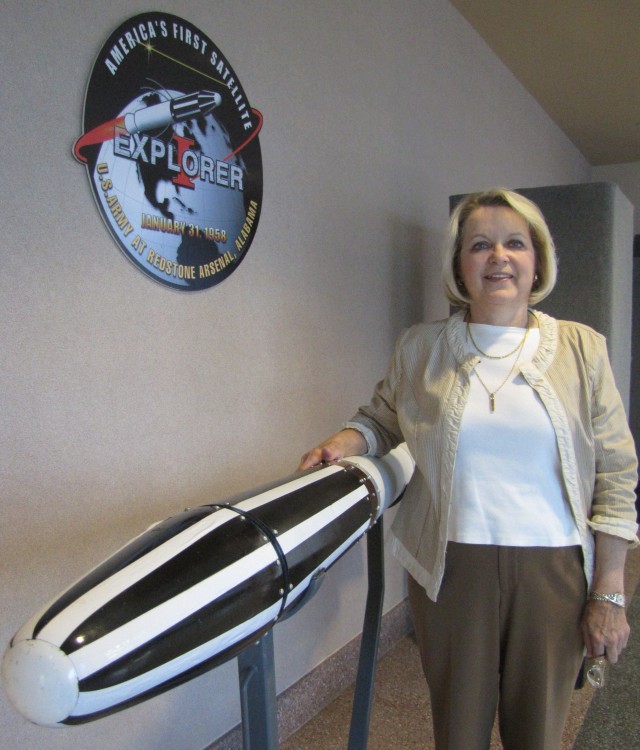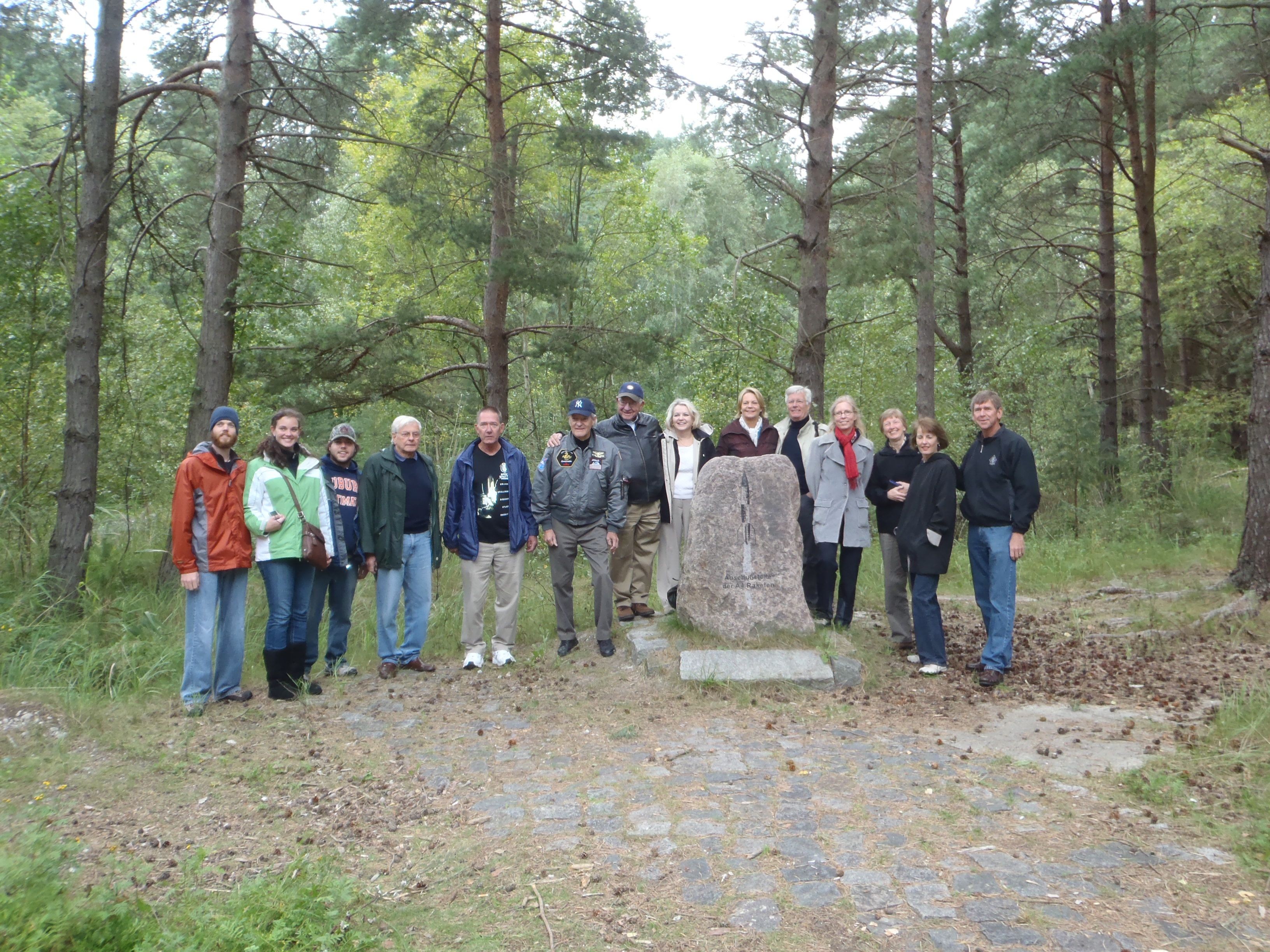REDSTONE ARSENAL, Ala. -- In the lush, green forest of eastern Germany on the Baltic Sea, Heidi Weber Collier discovered a little of her family's past.
Walking through woods that have grown up during the past 65 years, Collier was among 30 Americans whose interest in the area heralds back to the days of Dr. Wernher von Braun's first attempts to put a rocket in space. Collier's father - German engineer Fritz Weber - was among the more than 2,000 scientists who worked on rockets that were first destined for space but eventually used by the Germans to attack Europe.
Collier's family past includes Peenemunde and the V-2 rocket, remnants of Hitler's Germany and World War II.
But her family past also includes the Explorer I rocket, NASA's Marshall Space Flight Center, the Saturn V rocket and the first man on the moon.
And so, with such a famous family history, Collier wanted to see for herself where it all began for her father and other members of the German rocket team who were brought to the U.S. after World War II to begin the nation's space program. She was among 30 family members and friends of the German rocket team who visited Peenemunde in September.
"It's all grown up," she said of the fenced-in site, which was once the location of a power plant, liquid oxygen plant, wind-tunnel facility, rocket production facility, barracks, a prisoner of war camp, airfield, nine rocket test stands, and housing for engineers and scientists.
"After the war, this became Russian territory. All of the Army rocket research was removed - what could be removed - and the remaining buildings were exploded. It's been growing green for 65 years."
Peenemunde and all it represented remained "behind the curtain" in East Germany until the wall of communism fell in 1989. In 1991, a group of retired Huntsville engineers who worked at Peenemunde returned to the site where they sent the world's first rocket into space. While visiting, they filmed the documentary "Return to Peenemunde."
Although there is a Peenemunde museum, the rocket research center remains behind a locked fence. It is not a destination for tourists or sightseers interested in exploring World War II history. Peenemunde is still closed to the general public.
"People are just not let in. There is still a lot of unexploded ordnance in the ground. So people are kept out for safety reasons as well as other reasons," Collier said. "But there are several scientists who would like to reopen the site because it is the place where man put the first rocket into space."
It is a place where science and the military came together in a caustic way. It is a place where German scientists interested in space exploration were forced to discover rocket technology that the German army then used against all of Europe.
"There is a lot of political activism that surrounds Peenemunde, even today," Collier said. "To the Germans, it is a terrible thing. But the rocket research that came out of Peenemunde can't be ignored. It was the beginning of our space program.
"To the Germans, the questions about the use of prisoners of war for labor and the war itself make Peenemunde something that they want to forget, to bury. The German scientists at Peenemunde were civilians working on rockets and then there was the military. When work first began at Peenemunde it was all separate."
In the 1930s, von Braun and other rocket scientists were working with such organizations as the German Rocket Society. The young German scientists - many in their 20s -- studied the findings of American inventor Robert Goddard, who built the world's first liquid-fueled rocket. By 1935, von Braun and his team of about 80 scientists were firing liquid-fueled engines successfully in research funded by the German army.
But, in the midst of their studies of rocketry, the war began and their lives changed. Collier's father, an electronics engineer, was on a train in Berlin, getting ready to be shipped to the front, when he was pulled off the train and given a new assignment at Peenemunde. Another German scientist, Dieter Grau, who is now 97, was working on power plants on the Russian front, when his orders were changed and he was sent to Peenemunde.
"It was just a total culmination to have all their expertise there at Peenemunde," Collier said.
In 1937, Peenemunde became an extensive rocket development and test site. Located on the coast, it permitted the launching of rockets across about 200 miles of open water. Between 1937 and 1945, the German scientists led by von Braun developed many of the basics of rocket technology.
Von Braun was in charge of the V-2 project. Less than a year after the first successful launch of the V-2 into space and followed by the August 1943 British bombing raid on Peenemunde, mass production of the V-2 was moved to an underground factory in central Germany. Von Braun and his team remained at Peenemunde to continue testing.
"Von Braun's goal was 'we want to get to the moon.' When he spoke out about that goal, he was put in jail for two weeks. He was told that production of V-2s was his goal and he better get with it," Collier said, referring to a March 1944 statement by von Braun that he had a greater interest in developing the V-2 for space travel than as a weapon.
Collier has heard all the claims that von Braun and his team were aware of prisoner of war conditions, and the death of prisoners of war in connection with V-2 production. But the German scientists were, in their own way, also prisoners of war, being forced to work at the command of the German army, she said.
"We try to look at it in today's terms. But we can't," she said. "The freedoms we have here ... We can't fathom what they were up against. It was about survival. They were taking orders from the military without any communication with the outside world and in a locked, isolated area.
"They were always looking over their shoulders. Who's watching me' Who's after me' We can't understand that mentality."
The trip the Americans took to Peenemunde was coordinated by a German historian who does not want to be identified. Collier was joined by her two sons, Matt and John, along with John's fiancAfA, Megan Carrigan. Others in the group included Dr. Hannes Moik and Gerd Zeiler, related to Albert Zeiler, a German rocket team member who worked at launch control at Kennedy Space Center; Ed Buckbee, former public affairs officer for von Braun and former director of the U.S. Space & Rocket Center; Dr. Charlie Bradshaw, deputy director of von Braun's computer lab; Barbara Hoelzer-Beck, daughter of Dr. Helmut Hoelzer, who built the first analog computer and who was director of von Braun's computer lab, and her husband, Klaus Beck; Karen Thiel, grandniece of Dr. Walter Thiel, early guidance and control chief at Peenemunde who, along with his wife and two children, was killed in the British air raid of August 1943; and Evelyn Grau and Peter Grau, son and daughter of Dieter Grau, quality control chief for the German rocket team who is still alive at age 97, and Peter Grau's wife, Gail.
On the weekend of Sept. 8-11, Collier's group visited various locations at Peenemunde during the
day. At night, members of the group were joined by Peenemunde historians at a community center, formerly a forester's hut, for discussions and presentations pertaining to the German rocket team.
"We shared our personal stories and the experts told us the facts," Collier said. "All of us told stories about our fathers after they came to Redstone Arsenal. We talked about the Von Braun Hilton, the first building at Redstone with air conditioning, and how Dr. Hoezler insisted he would build his own air conditioning for his building.
"We talked about our fathers building furniture. They came here with nothing. And von Braun had to tell them 'Look, guys, too much time is being spent on building furniture. We have a goal to get to the moon. Get focused!'"
But among those stories of German ingenuity and industrious, there were also stories of fear.
"They were very grateful to be given the freedom and opportunities of America," Collier said. "But they were also so scared. They wanted their families to be safe. Always in the back of their minds was the great fear of being investigated and deported."
The group visited Test Stand VII, the site of the first successful launch into space of the A-4/V-2 on Oct. 3, 1942, and two other test stands. They saw the rubble of House 4, where von Braun had his office and living quarters; the site of House 31, where scientist Konrad Dannenberg lived; the bachelor quarters; and the corner of steps that once led into a production building. And they saw some underground stairs, and a cemetery where 280 people killed in 1943 and 1944 bomb raids are buried.
The group also visited the Peenemunde museum, where artifacts and displays are housed.
"The museum shows today's political slant," Collier said. "It shows the researchers and everyone connected to Peenemunde as being bad people. I don't think so. I look back and I'm grateful for the freedoms I was able to grow up with. These scientists didn't have that freedom. What happened to them was schickshal, a matter of fate."
Editor's note: In honor of the 60th anniversary of the German rocket team's move to Redstone Arsenal and the 50th anniversary of the establishment of Marshall Space Flight Center, the Redtsone Rocket is featuring the thoughts and memories of the last of the German rocket team and those associated with the early years of the U.S. space program in this series, titled Space Beginnings.




Social Sharing